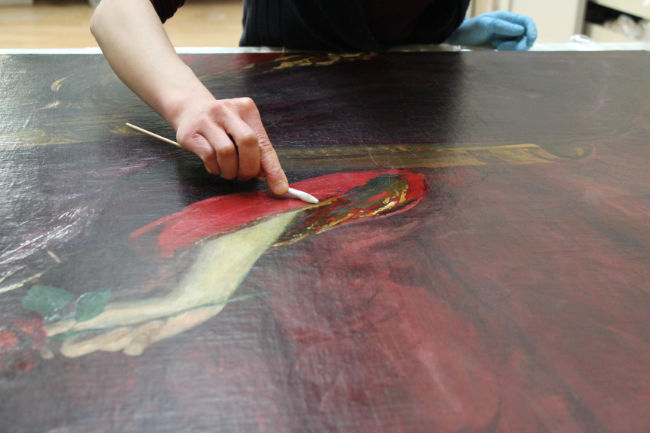
This painting was conserved in 2018 by Giulia Campagnari at the National Gallery of Ireland’s conservation studio through a shared NGI-CAG-IMMA Conservation Internship.
Significance
The Red Rose (1923) by John Lavery is among Crawford Art Gallery’s best-loved masterpieces. Signed ‘J. Lavery’ at bottom left, it is one of more than a staggering 400 portraits the artist made of his wife, artist and socialite Hazel Lavery (1880-1935), née Martyn. In his memoir, The Life of a Painter, Lavery lists this work under the title, The Red Rose – Hazel.

CAG.0081 John Lavery, The Red Rose, 1923, oil on canvas, 102.3 x 128 cm. Purchased, the Artist, 1925 (Gibson Bequest Fund).
Curiously, Hazel was not the first subject to be painted on this canvas, however, as it is known that portraits of Mrs William Burrell (1892), stage actor Sarah Bernhardt (1912), and the ‘Queen of Beauty’ Mary, Viscountess Curzon exist beneath. The frame, originally in portrait orientation, also bears the inscription ‘Vienna 1911’, which alludes to the canvas’ exhibition in Austria.
Lady Lavery was to become an emblem of modern Ireland when another portrait of her – as Kathleen Ní Houlihan, symbol of Irish nationalism – by her husband graced Irish banknotes, from 1928 until the 1970s. The portrait subsequently appeared as the watermark on Irish currency until the introduction of the Euro in 2002.
Crawford Art Gallery purchased The Red Rose from John Lavery in 1925 through the Gibson Bequest Fund and it remains a much sought after work in the Collection.
Assessment
Having spent much of the last decade travelling to prestigious locations, including Áras an Uachtaráin and Dublin Castle, it had become apparent that (like us all) the painting required some TLC.

Specifically, the canvas suffered from distortion along its left half and had developed a sharp crest and cracks, which caused flaking and losses of paint. Surface dirt and visible drying cracks were also present.
The ‘Facing’ Process
Based on this assessment, it was decided to transport The Red Rose to the National Gallery of Ireland, Dublin for treatment.


Prior to this, and for protection during transport, a ‘facing’ process was undertaken. Japanese paper (tissue) was applied with adhesive over the fragile flaking paint. Once it had arrived safely at its destination, the Japanese paper was removed and surface cleaning was carried out with aqueous solutions on cotton wool swabs. This is not unlike a delicate take on a skin-care regimen!


Treatment
The cracks at the centre-left were stabilized, re-activating – through application of heat and gentle pressure by hot spatula – an existing adhesive from a previous intervention. This treatment also made the canvas more flexible and allowed the conservator to address the crest in canvas and the deformation of the painting by keeping it under weights overnight.

The painting was then ‘keyed out’ to improve the tension of the canvas, making it taut rather like a drum. This solved the issue of distortion on its left section. The canvas was then retouched with reversible varnish colours on areas where there were paint losses and cracks.
Finishing Touches
During this process, the painting’s gorgeous gilt frame was also conserved. Before reframing the portrait, splinters of wood, cracks, and flaking gilding were stabilized by application of appropriate adhesives, and losses of gilding and paint were retouched.

Since its conservation, The Red Rose has returned to display regularly and in several new contexts, most recently in BEHIND THE SCENES: Collection at Work (26 November 2022 – 10 April 2023) in which this conservation work was highlighted.

'Behind The Scenes' at Crawford Art Gallery, Cork, Ireland, 2022 / Photograph: Jed Niezgoda - www.jedniezgoda.com
Text adapted from Conservation Report (2018) by Giulia Campagnari.
Learn more about John Lavery’s The Red Rose here.
Emmett Place, Cork, Ireland
T12 TNE6
Tel: 021 480 5042
info@crawfordartgallery.ie
Opening Hours
N.B. Last entry is 15 minutes before closing
Monday–Saturday 10.00am–5.00pm*
Thursday until 8.00pm
Sundays and Bank Holidays
11.00 am–4.00pm
© 2024 www.crawfordartgallery.ie